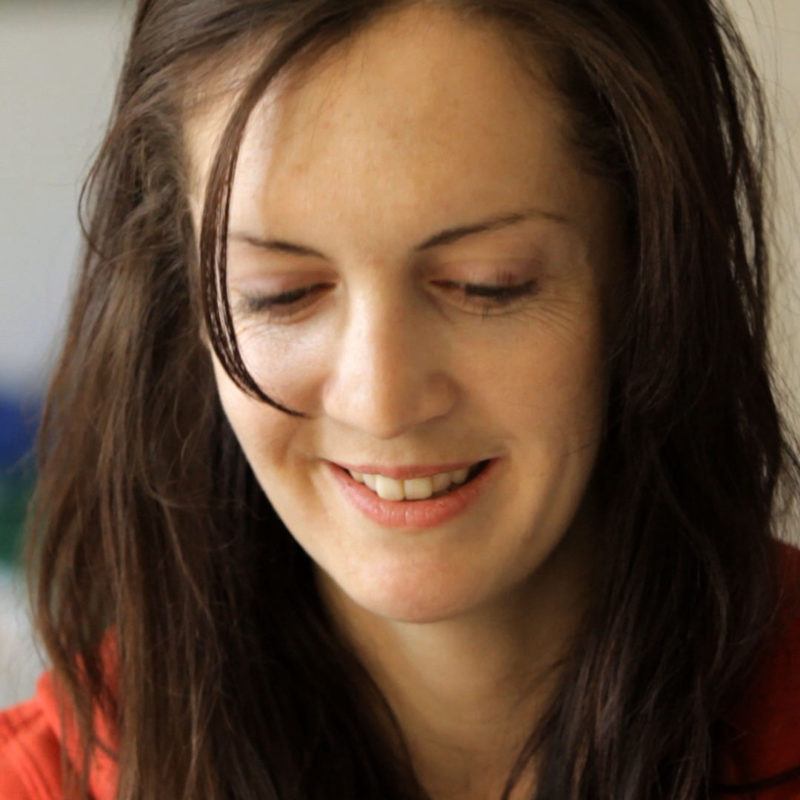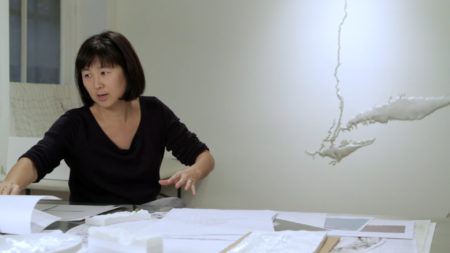Continue playing
(Time remaining: )
Play from beginning
Continue playing "{{ controller.videos[controller.getVideo(controller.currentVideo)].segmentParentTitle}}"
{{controller.videos[controller.getVideo(controller.currentVideo)].title}} has ended.
Mary Mattingly's Waterfront Development
What’s the latest trend in New York City real estate? Over the course of the summer and fall of 2013, artist Mary Mattingly constructs and occupies Triple Island (2013), an outdoor sculpture overlooking the East River. Situated in the newly developed Pier 42 public park—a waterfront area flooded by Hurricane Sandy in 2012—the sculpture rests on buoyant 55 gallon drums, which allow it to float in the event of rising sea levels.
Mattingly and friends build Triple Island out of a mix of recycled, donated, and custom-made materials. The three main structures—a living space, greenhouse, and community garden—together form a system for living off the grid in the densely-populated Lower East Side. A self-described apocalyptic thinker, Mattingly views the project as an experimental model for an imagined future where environmental degradation and collapsed economies render current ways of living in urban areas untenable.
“I think Triple Island has a very specific aesthetic intention,” says Mattingly, “and it is to imagine a world with leftover materials and how you would build and what it would look like.” Through summer heat and winter cold, the artist and several intrepid volunteers live in the sculpture, collecting rain for water, harnessing solar energy for power, and harvesting a garden for food. Residents’ motives for participating vary widely; for artist Ivan Gilbert, Triple Island offers a chance to gain “a few more degrees of relative freedom from giant inhuman institutions.” Partnering with a coalition of advocacy organizations, such as the Hester Street Collaborative and Lower Manhattan Cultural Council, Mattingly’s project is less an experiment in individualistic self-sufficiency as it is in the communal sharing of local resources.
Featuring the works Triple Island (2013) and Flock House Project (2012–13) with music by Chris Zabriskie.
Credits
Art21 New York Close Up Created & Produced by: Wesley Miller & Nick Ravich. Producer & Editor: Rafael Salazar & Ava Wiland. Cinematography: Nick Ravich, Rafael Salazar & Ava Wiland. Sound: Wesley Miller, Nick Ravich & Ava Wiland. Associate Producer: Ian Forster. Design & Graphics: Crux Studio & Open. Artwork: Mary Mattingly. Music: Chris Zabriskie. Thanks: Hannah Black, CAAAV: Organizing Asian Communities, Ian Daniel, Esteban Gaspar Silva, Ivan Gilbert, Good Old Lower East Side, Hester Street Collaborative, Chuck Lin, Greg Lindquist, Kelly Loudenberg, Lower East Side Ecology Center, Lower Manhattan Cultural Council, Nina Lucey, Rey Mendoza, Nancy Nowacek, Jess Segall, Mike Shuwerk, Lauren Slowick, Daija Solano, Two Bridges Neighborhood Council, Rand Weeks, Darren Will & Moira Williams. An Art21 Workshop Production. © Art21, Inc. 2014. All rights reserved.
Art21 New York Close Up is supported, in part, by the New York City Department of Cultural Affairs in partnership with the City Council; The Lambent Foundation; Toby Devan Lewis; the Dedalus Foundation, Inc., The Andy Warhol Foundation for the Visual Arts, and by individual contributors.
Closed captionsAvailable in English, German, Romanian, Italian, Japanese, Korean, Chinese, Italian
Through the Art21 Translation Project, multilingual audiences from around the globe can contribute translations, making Art21 films more accessible worldwide. Translate this video now.
Interested in showing this film in an exhibition or public screening? To license this video please visit Licensing & Reproduction.
Mary Mattingly was born in 1978 in Rockville, Connecticut, and lives and works in New York. Combining a visual-art practice with environmental activism and education, Mattingly wrote a manifesto that opens with the statement, “Art can transform people’s perceptions about value, and collective art forms can reframe predominant ideologies.” Mattingly’s determination to create alternative means of survival in the face of a dystopian future has resulted in various projects, from wearable cocoons that can store water and solar power to alternative urban infrastructure.
Water
Maya Lin
Roni Horn



